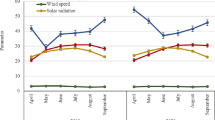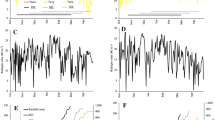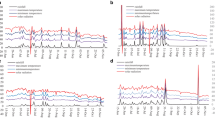Abstract
In the midsouth USA, soybean is produced either under irrigated or non-irrigated conditions. The objective of this experiment was to show the utility of supplemental irrigation as an alternative to full-season and non-irrigation to achieve high yield and high seed composition. The effects of irrigation and cultivar differences on soybean yield and seed composition were conducted. Two cultivars (Dwight and Freedom) and three irrigation regimes (full-season irrigation, FS; reproductive stage/supplemental irrigation, RI; and non-irrigation, NI) were used. Protein percentage was higher in Dwight under FS and RI than NI. In Freedom, protein percentage was higher under NI than under FS and RI. Under NI, Freedom had higher protein percentage than Dwight, especially in 2004, but lower oil in 2003 and 2004. Cultivars showed significant differences in fatty acids. Yield in Freedom under FS and RI was not significantly different. Nitrogen fixation was substantially higher under NI conditions. The results indicate that irrigation management and cultivar selection significantly affect seed composition and yield. Protein increase in Freedom under non-irrigated conditions may benefit producers for high protein seed under dry-land conditions. Supplemental irrigation at the reproductive stage may be a possible alternative for full season irrigation for the cultivar Freedom.


Similar content being viewed by others
References
Boydak E, Alpaslan M, Hayta M, Gercek S, Simsek M (2002) Seed composition of soybeans grown in the Harran region of Turkey as affected by row spacing and irrigation. J Agric Food Chem 50:4718–4720
Cherry JH, Bishop L, Hasegawa PM, Leffler HR (1985) Differences in the fatty acid composition of soybean seed produced in northern and southern areas of the USA. Phytochemistry 24:237–241
Delwiche CC, Steyn PL (1970) Nitrogen isotope fractionation in soils and microbial reactions. Environ Sci Technol 4:929–935
Dornbos DL, Mullen RE (1992) Soybean seed protein and oil contents and fatty-acid composition adjustments by drought and temperature. J Am Oil Chem Soc 69:228–231
Fehr WR, Welke GA, Hammond EG, Duvick DN, Cianzio SR (1991) Inheritance of reduced palmitic acid content in seed oil of soybean. Crop Sci 31:88–89
Frechilla S, Gonzalez EM, Royuela M, Minchin FR, Aparicio-Tejo PM, Arrese-Igor C (2000) Source of nitrogen nutrition (nitrogen fixation or nitrate assimilation) is a major factor involved in pea response to moderate water stress. J Plant Physiol 157:609–617
George T, Singleton PW 1992 Nitrogen assimilation traits and dinitrogen fixation in soybean and common bean. Agron J 6:1020–1028
Grieshop CM, Fahey GC Jr (2001) Comparison of quality characteristics of soybeans from Brazil, China, and the United States. Agric Food Chem 49:2669–2673
Guerin V, Trinchant JC, Rigaud J (1990) Nitrogen fixation (C2H2 reduction) by broad bean (Vicia faba L.) nodules and bacteroids under water-restricted conditions. Plant Physiol 192:595–601
Heatherly LG (1999) Soybean irrigation. In: Heatherley LG, Hodges HF (eds) Soybean production in the midsouth. CRC, New York, pp 119–141
Heatherly LG, Blaine A, Hodges HF, Wesley RA, Buehring N (1999) Variety selection, planting dates, row spacing, and seeding rate. In: Heatherley LG, Hodges HF (eds) Soybean production in the midsouth. CRC, New York, pp 41–47
Heatherly LG, Elmore CD, Wesley RA, Spurlock SR (2001) Row spacing and weed management systems for nonirrigated early soybean production system planting dates in the midsouthern USA. Crop Sci 41:784–791
Howell RW, Cartter JL (1958) Physiological factors affecting composition of soybeans. II. Response of oil and other constituents of soybeans to temperature under controlled conditions. Agron J 50:664–667
Maestri DM, Labuckas DO, Meriles JM, Lamarques AL, Zygadlo JA, Guzman CA (1998) Seed composition of soybean cultivars evaluated in different environmental regions. J Sci Food Agric 77:494–498
MSUCares. http://msucares.com/. Verified on 22 August 2007, Mississippi State University, Extension services. http://ext.msstate.edu/anr/drec/weather.cgi
Pefia-Cabriales JJ, Castellanos JZ (1993) Effects of water stress on N2 fixation and grain yield of Phaseolus vulguris L. Plant Soil 152:151–155
Peoples MB, Herridge DF (1990) Nitrogen fixation by legumes in tropical and subtropical agriculture. Adv Agron 44:155–223
Piper EL, Boote KJ (1999) Temperature and cultivar effects on soybean seed oil and protein concentrations. J Am Oil Chem Soc 76:1233–1242
Pote JW, Wax CL (1986) Climatological aspects of irrigation design criteria in Mississippi. Mississippi State University. Techn Bull 138:1–16
Purcell LC, King CA, Ball RA (2000) Soybean cultivar differences in ureides and the relationship to drought tolerant nitrogen fixation and manganese nutrition. Crop Sci 40:1062–1070
Rahman SM, Kinoshita T, Anai T, Takagi Y (2001) Combining ability in loci for high oleic and low linolenic acids in soybean. Crop Sci 41:26–29
Rakow G, McGregor DI (1973) Opportunities and problems in modification of levels of rapeseed C18 unsaturated fatty acid. J Am Oil Chem Soc 50:400–403
Ray JD, Heatherly LG, Fritschi FB (2006) Influence of large amounts of nitrogen on nonirrigated and irrigated soybean. Crop Sci 46:52–60
Schnebly SR, Fehr WR (1993) Effect of years and planting dates on fatty acid composition of soybean genotypes. Crop Sci 33:716–719
Schubert S (1995) Nitrogen assimilation by legumes—processes and ecological limitations. Fertil Res 42:99–107
Serraj R, Sinclair TR, Purcell LC (1999) Symbiotic N2 fixation response to drought. J Exp Bot 50:143–155
Shearer G, Kohl DH (1986) N2 fixation in field setting: estimation based on natural 15N abundance. Aust J Plant Physiol 13:699–756
Sinclair TR, Serraj R (1995) Legume nitrogen fixation and drought. Nature 378:344
Sinclair TR, Purcell LC, King CA, Sneller CH, Chen P, Vadez V (2007) Drought tolerance and yield increase of soybean resulting from improved symbiotic N2 fixation. Field Crop Res 101:68–71
Specht JE, Chase K, Macrander M, Graef GL, Chung J, Markwell JP, Orf HH, Lark KG (2001) Soybean response to water: a QTL analysis of drought tolerance. Crop Sci 41:493–509
Wilcox JR, Shibles RM (2001) Interrelationships among seed quality attributes in soybean. Crop Sci 41:11–14
Wilson RF (2004) Seed composition. In: Boerma HR, Specht JE (eds) Soybeans: improvement, production, and uses. American Society of Agronomy, Inc.; Crop Science Society of America, Inc.; Soil Science Society of America, Inc.; Wisconsin, USA, pp 621–668
Zhang LX, Zhang J, Kyei-Boahen S, Watson CE Jr (2004a) Developing phenological prediction tables for soybean. Online. Crop Manage. doi:10.1094/CM-2004-1025-01-RS
Zhang LX, Zhang J, Kyei-Boahen S, Watson CE Jr (2004b) Maturity date calculator—SoyPheno. http://msucares.com/deltasoy/gsModelFrame.htm
Zhang M, Kang MS, Reese PF, Bhardwaj HL (2005) Soybean cultivar evaluation via GGE biplot analysis. J New Seed 7:37–50
Acknowledgments
Authors gratefully acknowledge Dr. Larry G. Heatherly for his help with field work and comments on the manuscript, Dr. Robert Zablotowicz, Dr. Anne M. Gillen for comments on the manuscript, Dr. John Adamczyk, Abel Craig, and Leslie Price for technical assistance on isotope analyses. We thank Sandra Mosley for field and laboratory assistance. Also, we are grateful for the National Center for Agriculture Utilization Research (NCAUR), USDA-ARS, Peoria, IL, for seed composition analysis.
Author information
Authors and Affiliations
Corresponding author
Additional information
Communicated by S. Ortega-Farias.
Mention of trade names or commercial products in this publication is solely for the purpose of providing specific information and does not imply recommendation or endorsement by the US Department of Agriculture.
Rights and permissions
About this article
Cite this article
Bellaloui, N., Mengistu, A. Seed composition is influenced by irrigation regimes and cultivar differences in soybean. Irrig Sci 26, 261–268 (2008). https://doi.org/10.1007/s00271-007-0091-y
Received:
Accepted:
Published:
Issue Date:
DOI: https://doi.org/10.1007/s00271-007-0091-y




